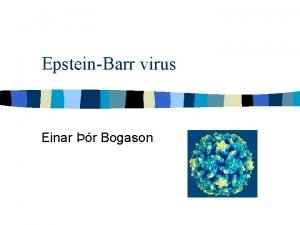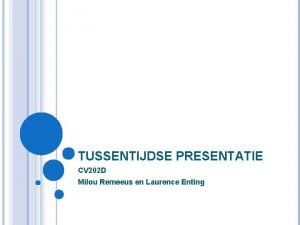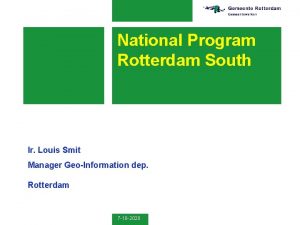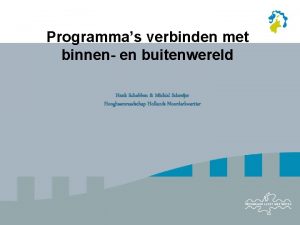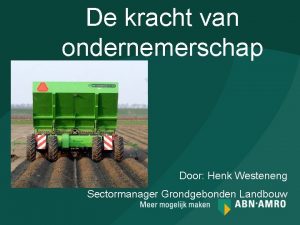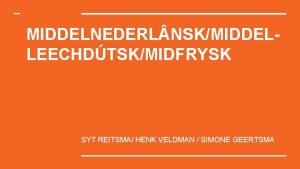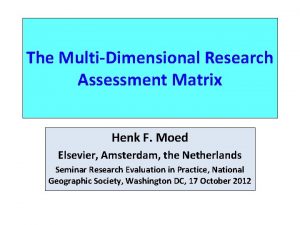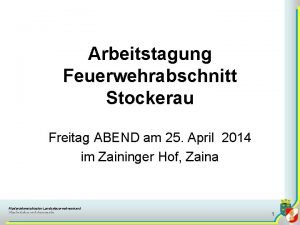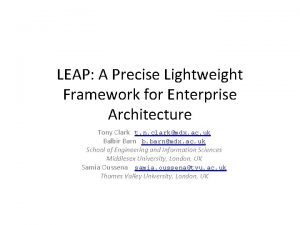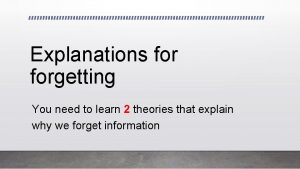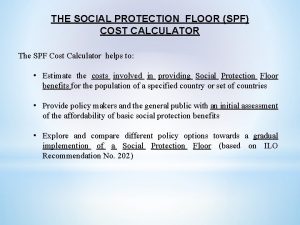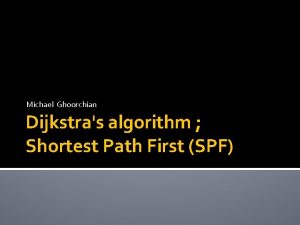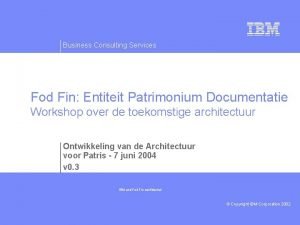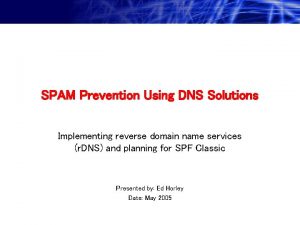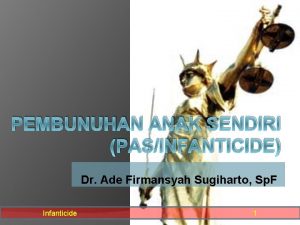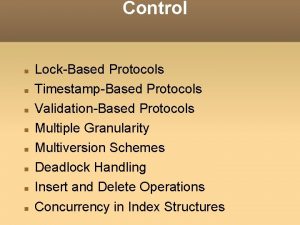Linkstate protocols SPF algo Henk Smit jan 1999








































- Slides: 40

Link-state protocols SPF algo Henk Smit jan 1999 0131_09 F 7/c 2 1

Summary • The basic ideas of link-state protocols • Dijkstra’s Shortest Path First algorithm 2

Summary • The basic ideas of link-state protocols • Dijkstra’s Shortest Path First algorithm 3

The basic idea • In a link-state protocol, the network can be viewed as a jigsaw puzzle • Each piece of the puzzle holds one router • Each router creates a packet which represents its own jigsaw piece • These packets are flooded everywhere • Use SPF to put the pieces together 4

About link-state protocols • The jigsaw puzzle LSP for router. B LSP for router. A to B to E to C to D to E to A to B LSP for router. E to A to D to B to C LSP for router. D LSP for router. C 5

Link-state protocols • Each router keeps track of its own state • Send and receive hellos to detect neighbors • Keep track of IP and CLNS addresses • interface IP prefixes • maybe inter-area or redistributed prefixes • Each router builds one linkstate packet (LSP) with all own local information • OSPF builds multiple LSAs for inter-area/externals 6

Link-state protocols • All routers exchange copies of all LSPs • via a reliable flooding mechanism • Each router stores all LSPs in a database • separate from the routing table • all routers should have exactly the same LSPDB • New LSPs sent only when there’s a change • and additionally periodic refreshes • new LSP will overwrite the old LSP – no partial updates 7

Link-state protocols • By executing Dijkstra’s SPF algorithm, each router ‘composes the jigsaw puzzle’. • the topology is calculated as a shortest-path-tree • each router is the root of the SPT it has calculated • From the SPT the RIBs are calculated • No routing loops will occur because • all routers have an identical LSPDB • all info in the LSPDB comes directly from the source – Distance Vector protocols are based on hear-say 8

Each router has the same LSPDB Router. A’s LSPDB lsp. A lsp. D lsp. B lsp. A Router. E’s LSPDB lsp. E lsp. C Router. B’s LSPDB lsp. E lsp. D lsp. C lsp. E lsp. B lsp. A lsp. C lsp. D lsp. E lsp. C lsp. D Router. C’s LSPDB lsp. A lsp. E lsp. C lsp. D Router. D’s LSPDB 9

Summary • The basic ideas of link-state protocols • Dijkstra’s Shortest Path First algorithm • Pseudonodes and Network LSAs • Flooding • Scaling link-state protocols by using areas • inter-area routing is IS-IS 10

Shortest Path First algorithm • Also called Dijkstra’s algorithm • The goal is to find the topology in the form of a shortest path tree (SPT) • From the SPT we build routing tables • Complexity is independent from position of computing router in the network • makes LS protocols less useful for hub-and-spoke • use distance-vector with default routes and filters Henk Smit jan 1999 11

Shortest Path First algorithm • SPF complexity is O(n log n) • Theoretical complexity depends on sorting • ISIS uses quick array sort – causes link metric limitation of 63 • CPU usage in real life depends on other stuff • number of links is important • number of IP routes, stability of adjacencies, etc • flooding is probably more important for scaling Henk Smit jan 1999 12

Shortest Path First algorithm • We maintain three lists (or sets) • Unknown list • all nodes start on this list • TENTative list • all nodes we are currently examining • also called candidate list • PATHS list • all nodes to which we have calculated final paths • also called known list Henk Smit jan 1999 13

Shortest Path First algorithm • We execute N steps • typically N is the number of nodes in the network • At each step we move one node to PATHS • During the first step we move ourself to PATHS • During the next steps we find the node that has the shortest path amongst all nodes on TENT, and move it from TENT to PATHS • At each step we find all neighbors reachable from that node and move them to the TENT list Henk Smit jan 1999 14

Shortest Path First algorithm • Special actions • after each step we clean up the TENT list • if a node is directly connected to us, search the first-hop info in the adjacency database • if a node is not directly connected to us, copy the first-hop info from the parent(s) • for each node on TENT, maintain the cost to get there from the root, and the first-hop info • if parallel paths, maintain multiple first-hops Henk Smit jan 1999 15

A network rtr. Z rtr. F 3 2 5 rtr. B 3 5 2 12 12 2 4 rtr. W Rtr. R rtr. C rtr. K 5 rtr. S 3 3 7 8 3 5 4 rtr. D 2 4 rtr. Q 5 3 rtr. A 16

The link-state database LSP Z IS: 3 C IS: 3 D LSP C IS: 2 B IS: 8 D LSP F IS: 5 B IS: 12 R IS: 5 B IS: 12 W IS: 2 K LSP B IS: 2 C IS: 2 R IS: 5 F LSP D IS: 3 A IS: 8 C IS: 3 R IS: 4 A LSP R IS: 3 D IS: 7 A IS: 3 W IS: 2 B IS: 12 F LSP A IS: 3 D IS: 4 D IS: 7 R IS: 3 W IS: 5 Q LSP K IS: 4 S IS: 2 F LSP W IS: 3 R IS: 3 A IS: 12 F IS: 5 S IS: 2 Q LSP S IS: 4 Q IS: 5 W IS: 4 K LSP Q IS: 5 A IS: 2 W IS: 4 S 17

The adjacency database Neighbor rtr. D rtr. R rtr. W rtr. Q Interface serial 0 serial 1 serial 2 serial 3 serial 4 serial 5 Cost 3 4 7 3 5 5 18

Shortest Path First example • Initial situation • TENT: empty • PATHS: empty • Unknown: A B C D F K Q R S W Z Henk Smit jan 1999 19

Shortest Path First example • First iteration • Move ourself (rtr. A) to PATHS • Move neighbors of rtr. A to TENT • find first-hop info in adjacency database • TENT: D cost 3 via S 0, R cost 7 via S 2, W cost 3 via S 3, Q cost 5 via S 4 or S 5 • PATHS: A • Unknown: B C F K S Z Henk Smit jan 1999 20

PATHS and TENT rtr. Z rtr. F 3 2 5 rtr. B 3 5 2 12 12 2 4 rtr. W Rtr. R rtr. C rtr. K 5 rtr. S 3 3 7 8 3 5 4 rtr. D 2 4 rtr. Q 5 3 rtr. A 21

Shortest Path First example • Second iteration • Move rtr. D to PATHS • Move neighbors of rtr. D to TENT • rtr. C and rtr. R, found better path to rtr. R, ignore rtr. A • TENT: W cost 3 via S 3, Q cost 5 via S 4/S 5, C cost 11 via S 0, R cost 6 via S 0 • PATHS: A, D cost 3 via S 0 • Unknown: B F K S Z Henk Smit jan 1999 22

PATHS and TENT rtr. Z rtr. F 3 2 5 rtr. B 3 5 2 12 12 2 4 rtr. W Rtr. R rtr. C rtr. K 5 rtr. S 3 3 7 8 3 5 4 rtr. D 2 4 rtr. Q 5 3 rtr. A 23

Shortest Path First example • Third iteration • Move rtr. W to PATHS, neighbors of rtr. W to TENT • F and S, found more equal-cost paths to R and Q • TENT: Q cost 5 via S 4/S 5/S 3, C cost 11 via S 0, R cost 6 via S 0/S 3, S cost 8 via S 3, F cost 15 via S 3 • PATHS: A, D cost 3 via S 0, W cost 3 via S 3 • Unknown: B K Z Henk Smit jan 1999 24

PATHS and TENT rtr. Z rtr. F 3 2 5 rtr. B 3 5 2 12 12 2 4 rtr. W Rtr. R rtr. C rtr. K 5 rtr. S 3 3 7 8 3 5 4 rtr. D 2 4 rtr. Q 5 3 rtr. A 25

Shortest Path First example • Fourth iteration • Move rtr. Q to PATHS, neighbors of rtr. Q to TENT • found worse path (9 vs 8) to S. A W already known • TENT: C cost 11 via S 0, R cost 6 via S 0/S 3, S cost 8 via S 3, F cost 15 via S 3 • PATHS: A, D cost 3 via S 0, W cost 3 via S 3, Q cost 5 via S 4/S 5/S 3 • Unknown: B K Z Henk Smit jan 1999 26

PATHS and TENT rtr. Z rtr. F 3 2 5 rtr. B 3 5 2 12 12 2 4 rtr. W Rtr. R rtr. C rtr. K 5 rtr. S 3 3 7 8 3 5 4 rtr. D 2 4 rtr. Q 5 3 rtr. A 27

Shortest Path First example • Fifth iteration • Move rtr. R to PATHS, neighbors of rtr. R to TENT • new path to B, worse to F. A D W already known • TENT: C cost 11 via S 0, S cost 8 via S 3, F cost 15 via S 3, B cost 8 via S 0/S 3 • PATHS: A, D cost 3 via S 0, W cost 3 via S 3, Q cost 5 via S 4/S 5/S 3, R cost 6 via S 0/S 3 • Unknown: K Z Henk Smit jan 1999 28

PATHS and TENT rtr. Z rtr. F 3 2 5 rtr. B 3 5 2 12 12 2 4 rtr. W Rtr. R rtr. C rtr. K 5 rtr. S 3 3 7 8 3 5 4 rtr. D 2 4 rtr. Q 5 3 rtr. A 29

Shortest Path First example • Sixth iteration • Move rtr. S to PATHS, neighbors of rtr. S to TENT • new path to K. Q W already known • TENT: C cost 11 via S 0, F cost 15 via S 3, B cost 8 via S 0/S 3, K cost 12 via S 3 • PATHS: A, D cost 3 via S 0, W cost 3 via S 3, Q cost 5 via S 4/S 5/S 3, R cost 6 via S 0/S 3, S cost 8 via S 3 • Unknown: Z Henk Smit jan 1999 30

PATHS and TENT rtr. Z rtr. F 3 2 5 rtr. B 3 5 2 12 12 2 4 rtr. W Rtr. R rtr. C rtr. K 5 rtr. S 3 3 7 8 3 5 4 rtr. D 2 4 rtr. Q 5 3 rtr. A 31

Shortest Path First example • Seventh iteration • Move rtr. B to PATHS, neighbors of rtr. B to TENT • better paths to C (10 vs 11) and F (13 vs 15) • TENT: C cost 10 via S 0/S 3, F cost 13 via S 0/S 3, K cost 12 via S 3 • PATHS: A, D cost 3 via S 0, W cost 3 via S 3, Q cost 5 via S 4/S 5/S 3, R cost 6 via S 0/S 3, S cost 8 via S 3, B cost 8 via S 0/S 3 • Unknown: Z Henk Smit jan 1999 32

PATHS and TENT rtr. Z rtr. F 3 2 5 rtr. B 3 5 2 12 12 2 4 rtr. W Rtr. R rtr. C rtr. K 5 rtr. S 3 3 7 8 3 5 4 rtr. D 2 4 rtr. Q 5 3 rtr. A 33

Shortest Path First example • Eigth iteration • Move rtr. C to PATHS, neighbors of rtr. C to TENT • B and D already known • TENT: F cost 13 via S 0/S 3, K cost 12 via S 3 • PATHS: A, D cost 3 via S 0, W cost 3 via S 3, Q cost 5 via S 4/S 5/S 3, R cost 6 via S 0/S 3, S cost 8 via S 3, B cost 8 via S 0/S 3, C cost 10 via S 0/S 3 • Unknown: Z Henk Smit jan 1999 34

PATHS and TENT rtr. Z rtr. F 3 2 5 rtr. B 3 5 2 12 12 2 4 rtr. W Rtr. R rtr. C rtr. K 5 rtr. S 3 3 7 8 3 5 4 rtr. D 2 4 rtr. Q 5 3 rtr. A 35

Shortest Path First example • Ninth iteration • Move rtr. K to PATHS, neighbors of rtr. K to TENT • found worse path to F (14 vs 13), S already known • TENT: F cost 13 via S 0/S 3 • PATHS: A, D cost 3 via S 0, W cost 3 via S 3, Q cost 5 via S 4/S 5/S 3, R cost 6 via S 0/S 3, S cost 8 via S 3, B cost 8 via S 0/S 3, C cost 10 via S 0/S 3, K cost 12 via S 3 • Unknown: Z Henk Smit jan 1999 36

PATHS and TENT rtr. Z rtr. F 3 2 5 rtr. B 3 5 2 12 12 2 4 rtr. W Rtr. R rtr. C rtr. K 5 rtr. S 3 3 7 8 3 5 4 rtr. D 2 4 rtr. Q 5 3 rtr. A 37

Shortest Path First example • Tenth iteration • Move rtr. F to PATHS, neighbors of rtr. K to TENT • all neighbors already known, no changes to TENT • TENT: empty • PATHS: A, D cost 3 via S 0, W cost 3 via S 3, Q cost 5 via S 4/S 5/S 3, R cost 6 via S 0/S 3, S cost 8 via S 3, B cost 8 via S 0/S 3, C cost 10 via S 0/S 3, K cost 12 via S 3, F cost 13 via S 0/S 3 • Unknown: Z Henk Smit jan 1999 38

PATHS and TENT rtr. Z rtr. F 3 2 5 rtr. B 3 5 2 12 12 2 4 rtr. W Rtr. R rtr. C rtr. K 5 rtr. S 3 3 7 8 3 5 4 rtr. D 2 4 rtr. Q 5 3 rtr. A 39

Shortest Path First example • Done ! • iteration stops because TENT is empty • we obviously didn’t find a path to Z • we can now calculate routing tables • result: D cost 3 via S 0, W cost 3 via S 3, Q cost 5 via S 4/S 5/S 3, R cost 6 via S 0/S 3, S cost 8 via S 3, B cost 8 via S 0/S 3, C cost 10 via S 0/S 3, K cost 12 via S 3, F cost 13 via S 0/S 3 Henk Smit jan 1999 40
 Bgp route monitoring
Bgp route monitoring The hiding place chapter 6
The hiding place chapter 6 Einkirningasótt smit
Einkirningasótt smit Biokybernetik nach smit
Biokybernetik nach smit Cv 202
Cv 202 Craig smit
Craig smit Ibm geographically dispersed resiliency for power systems
Ibm geographically dispersed resiliency for power systems Hospitality market in morocco
Hospitality market in morocco Aix smit
Aix smit Southir
Southir Henk schobben
Henk schobben Henk sterk
Henk sterk Henk van der kooij
Henk van der kooij Westeneng art
Westeneng art Henk nagel
Henk nagel Henk veldman enschede
Henk veldman enschede Henk f. moed
Henk f. moed Dr schouten
Dr schouten Ff zaina
Ff zaina Mandy henk
Mandy henk Henk van der kamp
Henk van der kamp Henk coetzee
Henk coetzee Henk roose
Henk roose Henk boterenbrood
Henk boterenbrood Henk corporaal
Henk corporaal Henk eleveld
Henk eleveld Henk boterenbrood
Henk boterenbrood Henk jonkers
Henk jonkers Henk schmidt et al 2000
Henk schmidt et al 2000 Spfs calculator
Spfs calculator Spf trosa
Spf trosa Spf shortest path first
Spf shortest path first Spf fin fod fin
Spf fin fod fin Algoritmo spf
Algoritmo spf Spf
Spf Sscn spf
Sscn spf Arteria mediana cubiti
Arteria mediana cubiti Efax spf record
Efax spf record Combell spf
Combell spf Spf theorie
Spf theorie Ade firmansyah sugiharto
Ade firmansyah sugiharto


